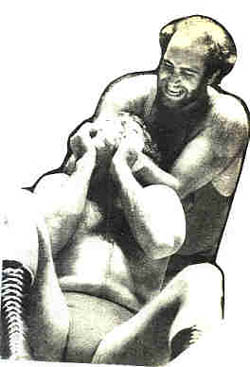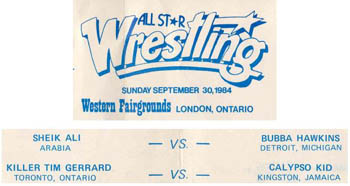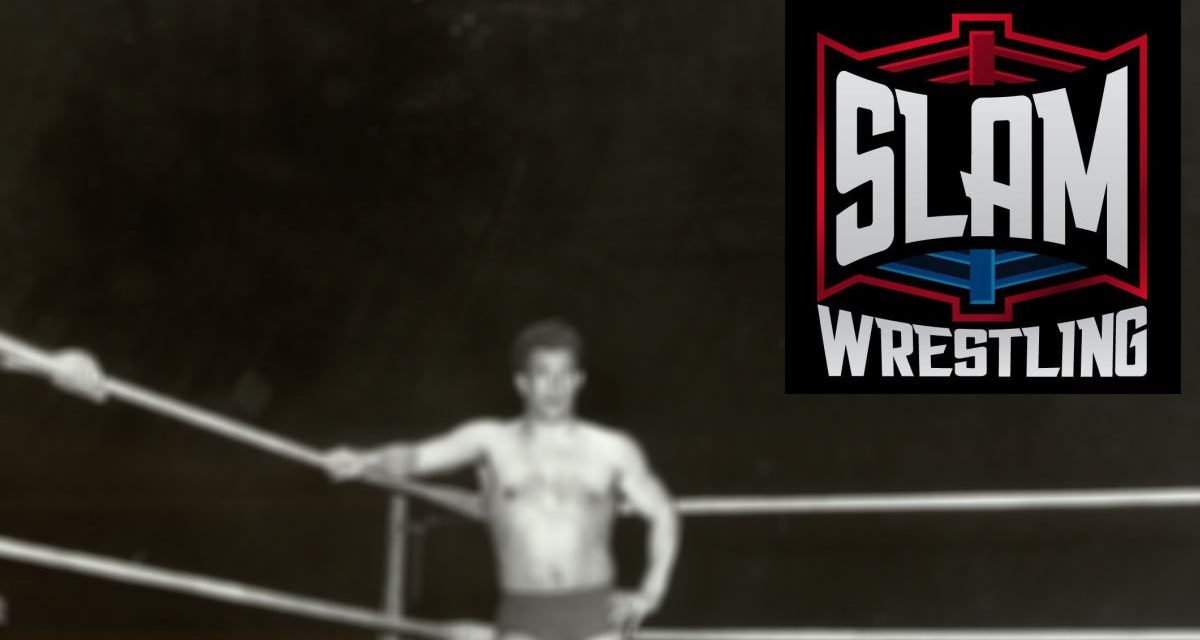The name may not jump off the page like a Roddy Piper or Ric Flair, but ask a Toronto fan about ‘our boys’ and they will likely list 6-foot-3, 260-pound, Guelph native Tim Gerrard among their favorites.

Tim Gerrard in action.
Gerrard recently talked about his career from 1980-1984, when he was regularly appearing on wrestling shows around the region.
Tim (whose last name is actually spelled Girouard) would begin his pro wrestling career like many others had before him — find a trainer in the area and learn the ropes at a local gym. In this case the trainer would be local star Dewey Robertson and the training ground Dewey’s gym in Burlington.
There would be no ropes though as there was no ring, just an old lumpy mat where the trainees would take bumps under the watchful eye of former Canadian champ Robertson.
“Dewey’s gym didn’t have a ring. I didn’t get into a ring until my first match so I had to learn the ropes and turnbuckles on the job,” Gerrard explained. “I tell you, back drops and slams were either heaven or hell depending upon where on the mat you landed.”
In that summer of 1980, Gerrard would be among the last group that Dewey trained before going full time for the Crocketts. Bill Armstrong and Claude Dion would step into Robertson’s void in training Gerrard. According to Gerrard, Robertson’s approach was simple: “I remember in training that Dewey explained the business in an odd way. All he did was, when someone had a hold, he got in their place and ‘sold’ the hold. He did it a couple of times and said that this is ‘selling.'”
Another wrestler who ran training facilities in the Toronto area over the years was Whipper (Phil) Watson Jr. “Phil was a nice guy. I met him through Big Mac when Phil was training guys out at Bernie Livingstone’s carpet place in Mississauga. Bernie was an old-time local jobber who had a ring set up in the back of his warehouse so guys could work out. Phil had me work out with a young guy, tall and slender, who later went by Danny Littlewolf. Danny was slick and ahead of the other students but had never worked with anyone large. Phil wanted me to slam Danny a bunch of times. I remember Danny must have only weighed about 170 or something so when you slammed him, you could actually get under him and throw him across the ring six or seven feet before he landed. The first time I scooped him all we heard was ‘OOOW, OOOW, OOOW!!’ and Phil standing outside just busting out laughing.”
The ring debut for Gerrard would come at the Germania Club in Hamilton in the fall of 1980, where they used to do the TV tapings. Trainer Robertson would offer up more advice on this day and Tim remembers it vividly. “The first time I worked was at the Germania club and Charlotte guys were just coming into Toronto. We dressed in the basement of the club and all of the guys came into the room and all dressed together. Being green, I asked Dewey if this is how it is all the time and he gave me the best piece of advice which I still use in new situations today, and that is he said ‘keep your mouth shut and your eyes open.’ It is still the best way to learn.”
That first match would also help to prepare him for the future ahead. Teamed with fellow local favorite Big Mac in a handicap match against then U.S. champ Jimmy Snuka, Gerrard was quick to learn about the ins and outs of pro wrestling. “Big Mac had a little more experience than me and he tried to leg drop Snuka’s arm but landed on Snuka’s bicep with his ass, which drove his head back as he landed and Mac hit his the back of his head on the mat which knocked him silly. He just laid there looking up at the lights and you could almost see little birds circling around his head like in the movies. Both Snuka and I realized what happened so Jimmy just picked Mac up, slammed him and pinned him. So ‘officially’ I did not get pinned in my first match.”
Still looking for his first break, Gerrard received it in the form of a phone call from Frank Tunney himself. “I always remember getting the call on a Friday afternoon at work from him. He called my house and my mom gave him my work number. He asked me if I could work Sunday at [Maple Leaf] Gardens. What a silly question. I remember my head was just spinning because I almost didn’t believe it happened.”
The matches against the familiar names would start shortly thereafter. Gerrard joked that his signature move was “the famous ‘holding them face down on the mat with me underneath them’ hold.” He would go on to work with some of the biggest stars in the game throughout his career in Toronto and in the U.S.
Ask Gerrard about who he enjoyed working with and the names ring off: Andre the Giant, Roddy Piper, Jimmy Valiant, and frequent NWA champ Ric Flair. “[Flair] had me backed into a corner and you know that Ric punches you with what appears to be a closed fist. When he backed me in and held my head I braced myself for a shot in the head but he was such a good worker that his fist was already going back after hitting me that I realized that he had hit me. It felt like such a tap. I also saw him once in Brantford for TV lying on the bench in the dressing room, sweating, having chills, in his gear but covered up with his suit coat, obviously ill. He worked a couple of times for TV and in the dark match. I thought what a guy, he never missed his spot, sick or not. But he was a party animal and had lots of stories to talk about with guys like Ray Stevens, Harley Race, etc.”
 |
Working with veterans like Ivan Koloff, Tony Parisi and Jody Hamilton would help Tim learn the craft and earn spots on Tunney’s shows outside the Toronto area. Kitchener, Belleville, and Dundas were regular stops as was Brantford. It was in the town where Wayne Gretzky was born that Gerrard had one of his more memorable bouts, meeting then-AWA champion Nick Bockwinkel.
Mostly wrestling from the heel corner meant Gerrard would face the fan favorites, among them five-time Canadian champion Angelo Mosca. “I worked many times with Angelo. He was always nice to me. He had a reputation of being ‘tough.’ Not ring tough but real life ‘tough.’ His reputation was that he took no sh– from anyone and didn’t like to get potatoed. Once in Guelph, he had me in an standing arm bar and told me to hit him in the chest. Well, I reared back but aimed a little high and clipped his lower jaw on the way to his chest. I had a quick flashback to his reputation and immediately said ‘sorry’ to him while in the ring. A minute or so later he had me bent over face down and gave me a forearm shot to my upper back, almost to the base of my neck that made my knees buckle, my eyes water and disoriented me for a few seconds. I thought to myself, ‘well there is my receipt from him.’ Later we became friends and I worked with him many times after that with no problems.”
In addition to the Tunney dates (Gerrard would also work under a mask as The Executioner), Gerrard was finding spots on The Sheik’s shows around Detroit and West Virginia. In the Detroit area he would sometimes work as ‘The Great Bolo’ (a name Frankie Laine bestowed on him) and would make forays into Trinidad (as The Assasin), Quebec, the Carolinas, and New York in his ring career.
Gerrard would also work on some of “The Wildman” Dave McKigney’s shows around Southern Ontario, including a stint under a mask as ‘The Assassin’ at the request of his old friend Watson. “He (McKigney) never really liked me,” Gerrard said. “He called me ‘one of Tunneys’ boys.’ I think as a rib he always called me ‘Alex’ (as in Alex Girard). I cancelled out on a couple of winter shows in North Bay and Sudbury once for him because the Tunneys gave me local work instead and I don’t think he liked it. He used me because Phil wanted to work with me.”
A program in the summer of 1982 led up to a ‘mask vs hair’ match against Watson with Tim — as The Assassin — having to unmask after being defeated by “Flying” Phil Watson. Gerrard related how this came about: “Phil was working for McKigney with Chris Colt across the territory. Chris cut his hand in Brampton taking a bump on some glass in a garbage can that came out when Phil hit him in the head with the can. Phil told Dave that he would work with me, I would be under the hood, and Chris would be my manager. We worked until Chris could get back into action. This is when we did the hair vs mask return match in Scarborough.”
In the summer of 1983, Gerrard would appear on the big Exhibition Stadium show billed as “The Night Of Champions.” The card, featuring six title matches, was also notable as Jack Tunney’s debut as head of the promotion (Frank Tunney, Jack’s uncle, had passed away in May.)
Jack Tunney, who passed away in January 2004, is remembered fondly by Gerrard. “He and I got along great because he had a sarcastic streak in him like me. I remember going to the office on Carlton [Street] across from Maple Leaf Gardens to pick up a cheque. The office looked awful. It had boxes and paper stacked up against the walls, very unkept and untidy. I mentioned to Jack about perhaps they could look into a cleaner or so and he said that they have been but ‘you have to get the right person and you just can’t rush it’ was his reply. I said ‘when did the last cleaner quit?’ and he said ‘1962.’”
Gerrard offered up some other tidbits about the Maple Leaf Wrestling regulars. Billy Red Lyons he revealed, was using the term ‘gibroni’ long before The Rock made it a household word. Norm Kimber, longtime Maple Leaf Wrestling announcer and partner, was adamant during the TV tapings that you “don’t jump up and down when you are in the ring on TV” because it made him go up and down and could make the fans at home nauseous.
John Bonello, who later reffed for Maple Leaf Wrestling, does not rate high on his list. “He was on his way up and had a sliver of success working with Randy Scott for The Sheik in Detroit and wasn’t as gracious as the guys on top who were already there.” David Sammartino (aka Bruno Jr.) also gets the thumbs down. “Tried to drop an elbow on me and landed on my face cracking my nose in Brantford.”
He admitted that he enjoyed working with most everybody he stepped in the ring with, whether it was the veterans or up-and-comers. “I wrestled Sabu a few times when he was just breaking in the business and working for his uncle The Sheik. He worked under his name Terry (billed as Terry S or Terry Essard) and he always wanted to splash me off the top rope but I didn’t want him to.”
As it was for many of the local workers (and many fans), the end came when the WWF took over the Toronto promotion in 1984. Gerrard would work his last match against The Samoans (The Islanders in Toronto in the ’70s) just as the New York promotion was coming into Toronto. “I got called for TV and showed up in Brantford expecting the Charlotte guys and there were all these new guys from New York — Gama Singh, the Samoans, Hulk Hogan.” Gerrard would suffer one of his more severe injuries in this match. Afa and Sika tried to fall-away slam him bringing him down on his shoulder and tearing the fibres around the tendons, bringing an end to his Maple Leaf Wrestling career.
Today, Gerrard lives in Guelph, and works at the Home Depot, running the contracting department.

